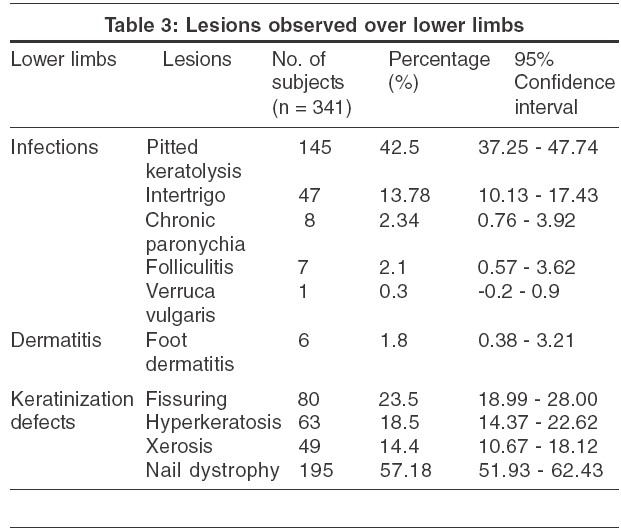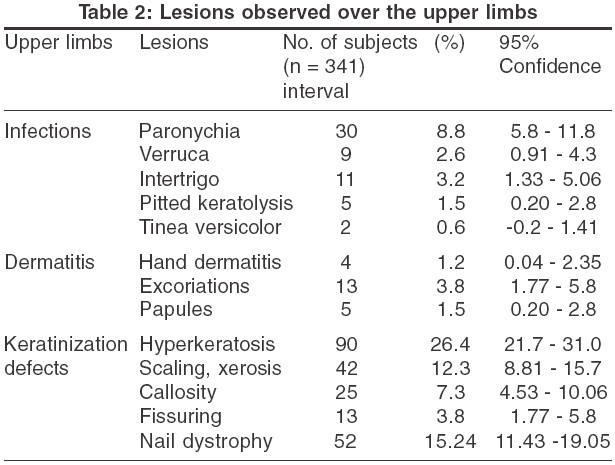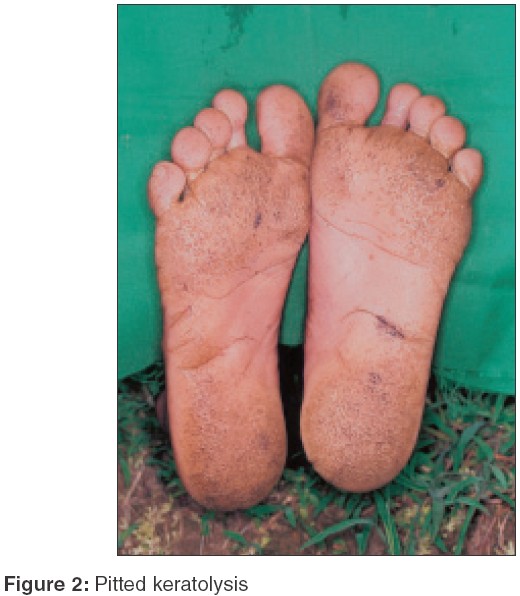Translate this page into:
Dermatoses among paddy field workers - A descriptive, cross-sectional pilot study
2 Departments of Microbiology, KMC, Manipal, India
3 Departments of Community Medicine, KMC, Manipal, India
Correspondence Address:
Shrutakirthi D Shenoi
Dept of Skin & STD, KMCH Manipal 576 104
India
| How to cite this article: Shenoi SD, Davis SV, Rao S, Rao G, Nair S. Dermatoses among paddy field workers - A descriptive, cross-sectional pilot study. Indian J Dermatol Venereol Leprol 2005;71:254-258 |
Abstract
BACKGROUND: Paddy farming is one of the main occupations in coastal South India. Dermatological problems in paddy field workers have not received much attention. AIM : The purpose of this study was to study the dermatoses of the exposed parts of the body, viz. face, hands, and feet, in paddy field workers. METHODS: Three hundred and forty-one workers were questioned and clinical findings noted. Scrapings for bacterial and fungal examination were taken by random selection. RESULTS: Seventy-three per cent had work-related itching. Melasma was the commonest facial lesion (41.1%). The main problems on the hands were hyperkeratosis (26.4%), nail dystrophy (15.2%) and paronychia (8.8%). Common feet dermatoses included nail dystrophy (57.1%), pitted keratolysis (42.5%) and fissuring (23.5%). Common aerobic and anaerobic bacteria isolated from pitted keratolysis and intertrigo were Klebsiella and Clostridium species. Aspergillus species were the commonest fungus grown from intertrigo. CONCLUSIONS: Occupational dermatoses are common in paddy field workers.







 |
 |
 |
 |
INTRODUCTION
Rice farming is one of the main occupations in South India. The initial preparation of the land (flooding, plowing the field, using manure, sowing the rice seeds in the soil) is done exclusively by men in the months of April and May. Seedlings (rice sprouts) are transplanted in the same field or a different one, a process called ′Natti′ in the local language. This work is done exclusively by women. For the next 3 months, the rice plants are left to grow into paddy. Male laborers use pesticides during this time. Once the paddy turns light brown, water is drained and the field is left to dry. After the drained field is completely dry and the plants turn hay-color, paddy harvesting is done by females, usually in October and November.
Paddy field workers are exposed to various agents, viz. irritants like mud, cow dung or other manure, fertilizers, pesticides and dust from the dried plant and grains during thrashing. The outdoor work also contributes to the effect of sunlight and wind. In addition, during the plowing and planting season, and sometimes in the harvesting season, the feet are constantly immersed in water. These factors can predispose workers to dermatoses of the face, hand and feet dermatitis, and bacterial and fungal infections. Cercarial dermatitis has been reported in paddy field workers in Assam,[1] the snails in the water acting as intermediate hosts. There is a paucity of reports regarding dermatological problems in rice field workers in coastal Karnataka.
Hence, this study was designed to gauge the point prevalence of dermatoses on exposed areas in the paddy field workers of Udupi district.
MATERIALS AND METHODS
Field visits were undertaken during either the replanting (June-July) or harvesting season (October-November). A house-to-house visit was also carried out with the help of a guide who knew the local residents involved in paddy field work. The medical team consisted of one senior dermatologist, 12 dermatology residents and 3 laboratory technicians. The farmers were randomly chosen and interviewed. Exposed areas, like the face, hands and feet, were examined and the findings recorded.
Scrapings from the hands and feet were collected from cases of pitted keratolysis and intertrigo with moderate-to-severe involvement, and incubated in brain heart infusion (BHI) broth for aerobic culture and Robertson′s meat medium for anaerobic culture. Aerobic subcultures were done from BHI broth after 12 hours to blood agar (BA), MacConkey′s agar and BHI agar and incubated at 370C for 72 hours. Colonies were identified by standard methods.[2] Anaerobic subcultures were done from Robertson′s meat medium after 24 and 48 hours on to neomycin blood agar, sheep blood agar and incubated in a Dyanox jar (Model 1:2) at 370C for 72 hours. Effective anaerobiosis was ensured and monitored by using both chemical and biological indicators. Colonies were identified by morphological, cultural and biochemical characteristics.[3]
Scrapings from intertrigo in selected cases were examined with 10% KOH. Specimens were also cultured in Sabouraud′s dextrose agar containing cycloheximide and chloramphenicol and incubated at 220C and 370C for up to 3 weeks.
Statistical analysis The prevalence of dermatoses and culture results were estimated and expressed in percentages. To understand the significance of prevalence, 95% confidence intervals of prevalence were also calculated. Statistical computation was done using SPSS package.
RESULTS
Out of 341 paddy field workers examined, there were 96 males and 245 females. Their age ranged from 16-80 years, with the maximum in the 31-40 year age group. One hundred and sixty workers (46.9%) were exposed to fertilizers and pesticides. One hundred and eighty-six workers (54.5%) had a past history of skin disease.
Two hundred and forty-nine workers (73%) complained of itching during and after work. It was worse during harvesting and thrashing. Other work-related symptoms were urticaria and asthma in nine workers each (2.6%), photosensitivity in three (0.9%), and rhinitis and burning sensation in two each (0.6%). Melasma (41.1%) and freckles (11.75%) were the commonest facial
each (2.6%), photosensitivity in three (0.9%), and rhinitis and burning sensation in two each (0.6%). Melasma (41.1%) and freckles (11.75%) were the commonest facial
lesions [Table - 1].
The commonest dermatoses observed over the upper limbs [Table - 2] were nail dystrophy (15.24%), and paronychia (8.8%).
On the lower limbs [Table - 3], the majority (57.18%) of workers had nail dystrophy [Figure - 1]; other common disorders were pitted keratolysis [Figure - 2] (42.5%), and intertrigo (13.78%). Fissures, hyperkeratosis and xerosis were seen in 80 (23.5%), 63 (18.5%) and 49 (14.4%) workers respectively.
The results of bacterial culture are shown in [Table - 4]. In pitted keratolysis (n=48), the commonest aerobic organisms grown included Klebsiella , Acinetobacter and Pseudomonas . In intertrigo (n = 29), the frequent aerobic isolates were Klebsiella and coagulase negative Staphylococci . The commonest anaerobic organisms from pitted keratolysis and intertrigo were Clostridium species.
Two hundred and six workers (60.4%) took a bath after work and applied coconut oil as a protective measure to prevent or control itching.
DISCUSSION
In this pilot study of paddy field workers, there were more females (71.8%) than males. The female preponderance was due to the fact that the field visits were undertaken in the transplantation and harvesting season when mostly females are employed. The rest of the work like plowing, preparation of land and spraying insecticides is done exclusively by males in this part of the country.
Two hundred and forty-nine workers (73%) complained of itching during and after work, especially during the harvesting and thrashing season. Severe pruritus upon exposure to grain dust is common during rice harvesting and is due to mechanical irritation from fibers in the dust and resolves after bathing.[4]
Paddy ( Oryza sativa ) belongs to the grass ( Graminae ) family. Many grasses, including paddy, can traumatize the skin by their thin prickly spikes or by laceration.[5] They can also produce urticarial papules in workers handling crops or litter straw.[6] Dermatitis has been reported in Europe and America from de-husking rice, millets and barley,[6] but in India there are few cases where dermatitis could be definitely attributed to working with these grains.[5]
Parasites of grain can cause skin irritation from grain dust due to parasito-phytodermatitis or pseudo-phytodermatitis. ′Straw itch′, ′grain itch′ and itching from contact with cereals can be caused by the Pyemotes species which is a mite parasitic on the larvae of many insects.[7],[8]
Although most workers reported itching, there was a low prevalence of hand and feet dermatitis possibly due to the cleanliness measures adopted by the workers. A noteworthy point was that most workers took a bath after work and applied coconut oil. Although the sensitization potential of Oryza sativum is low, we have observed a positive patch test to 10% paddy extract in four patients with suspected plant dermatitis in our hospital (unpublished observation).
The commonest pigmentary disease on the face was melasma (41%), followed by freckles (11.7%). Although the pathogenesis of melasma is unclear, hormonal factors have been implicated.[9] Both melasma and freckles are known to worsen after sun exposure. Tinea versicolor, a superficial fungal infection, was seen in 6.5% of cases over the face. This infection seems to prefer hot and humid weather.[10]
Chronic paronychia of the fingernails was seen in 8.8% of cases and, of toenails, in 2.1%. Chronic paronychia, earlier believed to be a candidal infection, is now considered as a type of hand dermatitis precipitated by environmental exposure.[11] Mechanical trauma is an important predisposing factor in chronic paronychia.[12] Most of our subjects were housewives and were exposed to various irritants like mud, cow dung and manure during their work, in addition to soaps and detergents at home.
Pitted keratolysis was found in 43.40% of cases. It is a superficial infection of the skin confined to the stratum corneum and characterized by bilaterally symmetrical discrete and confluent shallow pits on the pressure-bearing areas of the soles and rarely on the palms. Palmar involvement was seen in 1.5% of patients. The various organisms implicated include Corynebacteria species,[13] Micrococcus sedentarius[14] and Dermatophilus congolensis .[15] In our study, the most frequent organisms isolated were Klebsiella , Acinetobacter , Pseudomonas and Clostridium species.
Intertrigo was seen in 17.01% of the workers. Foot intertrigo is usually a mixed infection caused by dermatophytes, yeasts, and Gram-positive and Gram-negative bacteria.[16] In our series, no dermatophyte or candida was isolated. The commonest organisms cultured included Klebsiella , coagulase negative Staphylococci, Clostridium and Aspergillus .
A large proportion of the workers had palmar and plantar hyperkeratosis, fissuring and scaling. Palmar lesions were attributed to the manual work, while feet lesions were due to constant trauma to the bare feet, as the workers did not use footwear in the fields.
Dystrophy of fingernails was seen in 15% of workers and, of toenails, in 57%. The causes could be fungal infection, secondary to chronic paronychia or due to occupational trauma. No attempt was made to culture the nail plate or the subungual debris for fungi.
In a study of Polish farmers, allergic contact dermatitis was the commonest dermatosis, followed by infections, irritant contact dermatitis and urticaria.[17] In a Scandinavian study of farmers, toenail maceration was the most common dermatosis seen on clinical examination, but not reported.[18]
In conclusion, toenail dystrophy, pitted keratolysis and melasma were the most frequent conditions encountered in paddy field workers.
Acknowledgment
We would like to thank the postgraduate students and the technicians of the Department of Dermatology and Mrs. Jayanthi Nayak for their invaluable assistance.
| 1. |
Narain K, Mahanta J, Dutta R, Dutta P. Paddy field dermatitis in Assam: a cercarial dermatitis. J Commun Dis 1994;26:26-30.
[Google Scholar]
|
| 2. |
Cowan ST. In : Cowan and Steel's manual for the identification of medical bacteria 2nd edn. Barrow GI, Feltham RKA editos Editors. LondonL: Cambridge University Press; 1974. p. 45-122.
[Google Scholar]
|
| 3. |
Willis AT. In : Anaerobic bacteriology. Clinical and laboratory practice 3rd edn. Willis AT, editor. London: Butterworth; 1979. p. 48-52.
[Google Scholar]
|
| 4. |
Niels KV. Occupational dermatoses in farmers. In : Occupational and Industrial Dermatology 2nd edn. Maibach HI editor. Chicago: Year Book Medical Publisher; 1987. p. 437.
[Google Scholar]
|
| 5. |
Behl PN, Captain RM, Bedi BM, Gupta S. Skin irritant and sensitizing, plants found in India. New Delhi; 1966.
[Google Scholar]
|
| 6. |
Mitchell J, Rook A. Botanical Dermatology - Plants and plant products injurious to the skin. 1st edn. Greengrass: Vancouver; 1979. p. 28-337.
[Google Scholar]
|
| 7. |
Uenotsuchi T, Satoh E, Kiryu H, Yano Y. Pyemotes dermatitis caused by indirect contact with husk rice. Br J Dermatol 2000;143:680-2.
[Google Scholar]
|
| 8. |
Betz TG, Davis BL, Fournier PV, Rawlings JA, Elliot LB, Baggett DA. Occupational dermatitis associated with straw itch mites (Pyemotes ventricosus). JAMA 1982;247:2821-3.
[Google Scholar]
|
| 9. |
Kroumpouzos G, Cohen LM. Dermatoses of pregnancy. J Am Acad Dermatol 2001;45:1-19.
[Google Scholar]
|
| 10. |
Halder PM, Nandedkar MA, Neal KW. Pigmentary disorders in ethnic skin. In : Dermatologic Clinics - Ethnic skin diseases. Halder KM editor.USA: WB Saunders Co ; 2003. p. 617.
[Google Scholar]
|
| 11. |
Tosti A, Piraccini BM, Ghetti E, Colombo MD. Topical steroids versus systemic antifungals in the treatment of chronic paronychia: an open randomized double blind and double dummy study. J Am Acad Dermatol 2002;47:73-6.
[Google Scholar]
|
| 12. |
Chow E, Goh CL. Epidemiology of chronic paronychia in a skin hospital in Singapore. Int J Dermatol 1991;30:795-8.
[Google Scholar]
|
| 13. |
Zais N. Pitted and ringed keratolysis. A review and update. J Am Acad Dermatol 1982;7:787-91.
[Google Scholar]
|
| 14. |
Nordstrom KM, McGinley KJ, Capiello L, Zechman JM, Leyden JJ. Pitted keratolysis: The role of Micrococcus sedentarius. Arch Dermatol 1987;123:1320-5.
[Google Scholar]
|
| 15. |
Woodgyer AJ, Baxta M, Rush - Munro FM, Brown J, Kaplan W. Isolation of Dermatophilus congolensis from two New Zealand cases of pitted keratolysis. Australas J Dermatol 1985;26:29-35.
[Google Scholar]
|
| 16. |
Kates SG, Nordstrom KM, Mc Ginley KJ, Leyden JJ. Microbial ecology of interdigital infections of toe web spaces. J Am Acad Dermatol 1990;22:578-82.
[Google Scholar]
|
| 17. |
Spiewak R. Occupational dermatoses among Polish Private farmers. Am J Ind Med 2003;43:647-55.
[Google Scholar]
|
| 18. |
Susitaival P, Husman L, Hollmen A, Horsmanheimo M. Dermatoses determined in a population of farmers in a questionnaire based clinical study including methodology validation. Scand J Work Environ Health1995;21:30-5.
[Google Scholar]
|
Fulltext Views
6,787
PDF downloads
2,272





